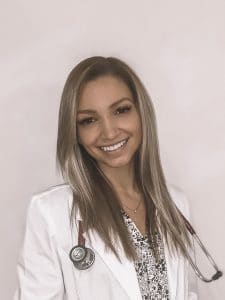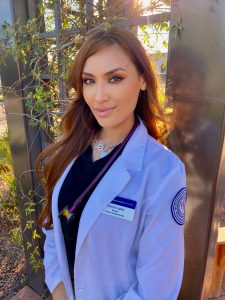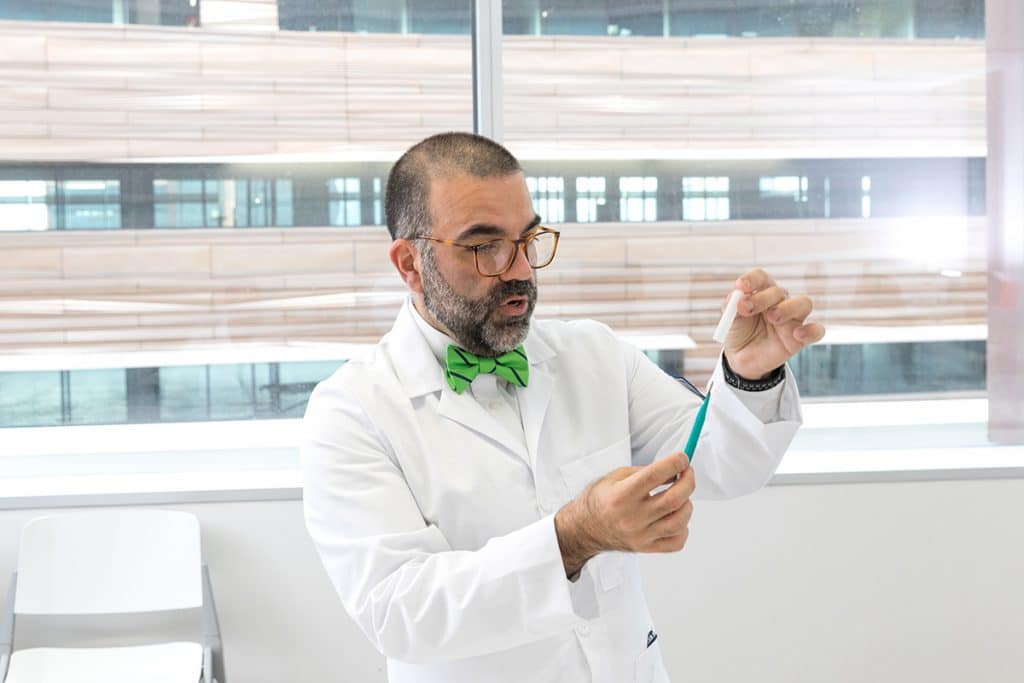For years, Misha Kocela’s goal was to be a physician assistant. She majored in kinesiology at Arizona State and spent a gap year working Monday through Friday as a certified nurse’s assistant and patient advocate at a surgery center in Phoenix and weekends has an EKG tech at a hospital. She took her place as part of Northern Arizona University’s 2022 PA cohort.
But it didn’t really sink in until the fall semester, in a class on taking patient histories and conducting physical exams. She and her classmates practiced on each other, and it struck her that these interactions are the first and often the most useful they have with patients. So, doing them effectively and kindly matters.
“That’s when it hit me—I’m going to be a PA,” she said. “This is how I’m doing it.”
Kocela is one of 100 students enrolled in NAU’s PA program, which is one of only three programs in the state of Arizona and the only public-school program in the state. She and her classmates are working to fill a critical shortage in health care providers, which is even worse in rural areas and in the field of primary care.

The PA program, which is based at the Phoenix Biomedical Campus in downtown Phoenix, has doubled in size since its inception in 2014. This year, NAU got approval to add another 10 students to its next class, so 60 students will start in the fall.
For program director Elias Villarreal, the news couldn’t come soon enough.
“NAU’s program is growing in response to the need for more PAs in primary care,” he said. “Part of our mission is to address underserved and rural areas, especially in primary care.”
Physician assistants work on a health care team with nurses, doctors and other PAs, with responsibilities that include examining patients, diagnosing, treating, prescribing medications, ordering and interpreting labs and radiology. They practice in every field of medicine, including every specialty. The profession was founded in the 1960s to address the shortage, aiming in part to give health care providers more flexibility.
NAU’s program

Students earn a master’s degree in 24 months, starting with a year of intense classroom learning. (Although classes are virtual now because of the pandemic, the program is typically fully in-person.)
The second year, students rotate through eight clinical apprenticeships, ranging from free clinics to specialty hospitals, rural providers and family practices. This allows students to log 1,760 hours getting hands-on training offering care to patients and doing the same type of work they’ll be doing after graduating.
“It’s just really pedal to the metal,” Villarreal said.
NAU students come from diverse backgrounds and with different goals for their work.
- About 85 percent of NAU graduates stay in Arizona after graduating.
- 37 percent of NAU’s students are from underrepresented minority groups.
- 33.6 percent of graduates are practicing in primary care.
- 68.3 percent of graduates are practicing in medically underserved communities, like rural areas or in the inner city where there’s little access to care.
- NAU’s program is ranked 37th in the nation by U.S. News and World Report.
Students are required to enter the program with experience in health care. For Bianca Lopez, a second-year student, that was working as a paramedic and in an emergency room. That experience, coupled with her education, have helped her find success in her rotations and feel confident in her career choice.

“I know I was meant to help others in the medical field,” Lopez said. “The reason I chose to be a physician assistant over other roles is that a PA can practice in any area of medicine, and I find many disciplines in medicine fascinating. Knowing that I can practice in as many fields as I desire is the most appealing feature of this profession.”
Lopez and her cohort are about halfway through their clinical rotations; they’ll graduate in August. She’s on an internal medicine rotation in a Phoenix hospital, and every day is busy—the fast-paced learning environment of her first year at NAU helped her adjust to the fast pace in a hospital. Working with a preceptor, she sees patients as they are admitting, gathering their health history and administering a physical exam. Then she creates a treatment plan for each patient.
“Creating the treatment plan is the most challenging because it requires me to think critically,” she said. “Every patient encounter brings a new learning opportunity. Learning new things is an exciting part of every day.”
The day is a little more predictable, though not less busy, for first-year students. Kocela has classes all day; during the pandemic, the students are divided into two groups and each group has a full week on campus, then does the next week virtually. Either way, she reviews lectures and notes before classes and then again in the evening, sometimes studying in groups and others on her own.
She hasn’t settled on a specialty yet; she likes family practice, dermatology and orthopedic surgery. Which is fine, she’s quick to add—everyone tells first-years they’ll change their mind during the rotations. Or she can start in one and switch specialties, one of the perks of the more adaptable PA profession.
After her experiences in emergency rooms, Lopez is leaning toward specializing in emergency care. When her cohort graduates in August, they’ll take the Physician Assistant National Certifying Exam. Many take jobs at clinics where they interned, Villarreal said.
Why NAU?
Both Lopez and Kocela saw NAU as their obvious choice—location, affordable tuition, its national rankings. But more than logistics attracted each woman. For Lopez, doing clinical rotations locally gives her the opportunity to network with the people she hopes will soon be her peers. Also, she said, NAU chose her when she was selected as a health path scholar in 2018.
“This is a unique program that creates a path for a select few,” she said. “I was challenged with physician assistant education courses and I received mentoring that helped me build confidence and taught me how to be successful in PA school. It truly was a valuable opportunity.”
Learn more about NAU’s PA program.
For Kocela, who came to Arizona by way of New Jersey, NAU had been her dream program since she’d decided she wanted to be a PA. Program alumni helped convince her, and the application process cemented her choice.
“When I interviewed, I felt most comfortable talking to faculty at NAU than anywhere else I interviewed,” she said.
For the community, the flip side of that question is simple: NAU PA students are assets to the places where they work. Dr. Linda Som is one of the preceptors who works with NAU students and hires NAU graduates. She runs the Arizona Medical Clinic, a family practice with patients from newborns to centenarians. This means that, in their three clinics plus a mobile clinic, they’re managing chronic conditions, doing preventive screenings, treating acute illnesses and doing minor surgery. Several of the providers right now are NAU PA students.
“NAU students are smart, eager to learn and kind-hearted,” she said. “I believe NAU PA students are ready to be great providers once they finish their rotation.”
Learn more from PA student Chianti Zerner, who did an Instagram Live with NAU Social.

Heidi Toth | NAU Communications
(928) 523-8737 | heidi.toth@nau.edu




